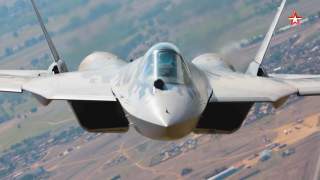Russia Is Going Hypersonic: As in Hypersonic Missiles on Su-57 Stealth Fighters?
Maybe. However, we know for sure they are on MiG-31s. Here is what we can tell you.
Earlier last week, the press office of the Russia-hosted International Army Games announced that Russia’s nuclear-capable, hypersonic Kh-47M2 Kinzhal missile will be publicly displayed for the first time at the Aviadarts 2019 aviation competition: "During the Aviamix tactical episode that will be held at the Dubrovichi training range on August 10 as part of the Aviadarts 2019 international competition, the Kinzhal airborne missile system will be involved for the first time. MiG-31 planes will interact with MiG-31BM interceptor-fighters to provide cover for attack aircraft in destroying a battery of a notional enemy’s surface-to-air missile systems.”
A recent Russian state news television segment depicts scenes from the event, held in the Ryazan Oblast just to the southeast of Moscow. Taken together, the abbreviated clips show what appears to be Kinzhal-equipped MiG-31’s providing cover for a Su-34 strike group as the latter drops a cluster of bombs over a plain containing around 60 practice targets-- a later clip in the same video depicts the moment of impact.
There were no demonstration launches of the Kinzhal missile itself, a source of confusion borne from headlines stating that Russia will “employ” Kinzhal at Aviadarts 2019 and treating the Kinzhal-equipped MiG-31’s as the centerpiece of the event.
Kinzhal has been confirmed for compatibility with the MiG-31 and Tu-22M3, each capable of mounting one or four Kinzhal missiles respectively. 10 MiG-31 units have so far been upgraded to the Kinzhal-compatible, “MiG-31K” standard. In addition, Russia’s defense industry is working on a “Kinzhal-like” hypersonic missile that is small enough to be mounted on the upcoming, supermaneuverable Su-57 fifth-generation air superiority fighter; it is unknown whether this Su-57 missile will be a smaller Kinzhal variant or a different hypersonic missile with performance characteristics similar to Kinzhal. Earlier this year, it was revealed that Russia is considering a land-launched Kinzhal variant as a possible response to Washington’s then-planned, and now-confirmed, withdrawal from the Intermediate-Range Nuclear Forces Treaty (INF). According to Russian general-lieutenant Evgeny Buzhinskiy, tweaking already-existing Kinzhal technology for compatibility with land-based platforms would be exponentially cheaper and faster than researching, developing, and producing entirely new long-range land and cruise missiles.
Now in service in Russia’s Southern Military District, Kinzhal was one of several flagship weapons unveiled at Russian President Vladimir Putin’s much-cited annual state-of-the-nation address at the beginning of 2018. Putin’s speech and subsequent Russian commentary stressed that Kinzhal’s hypersonic travel speed and capacity to maneuver in mid-flight render it non-interceptable by any existing missile defense system, while its alleged range of 2,000 to 3,000 kilometers promises to be a major boon for Russian threat projection against critical land infrastructure and large surface targets like carrier strike groups.
As with the upcoming Avangard hypersonic glide vehicle and Sarmat thermonuclear heavy ICBM, Kinzhal reflects the essence of Moscow’s new nuclear deterrence doctrine: instead of trying to match NATO’s combined nuclear warhead output in a costly, ill-fated arms race, the Kremlin is developing a handful of hypersonic delivery systems that they believe will ensure their first-strike capability into the mid 2020’s.
Mark Episkopos is a frequent contributor to The National Interest and serves as research assistant at the Center for the National Interest. Mark is also a PhD student in History at American University.
Image: Screenshot.

